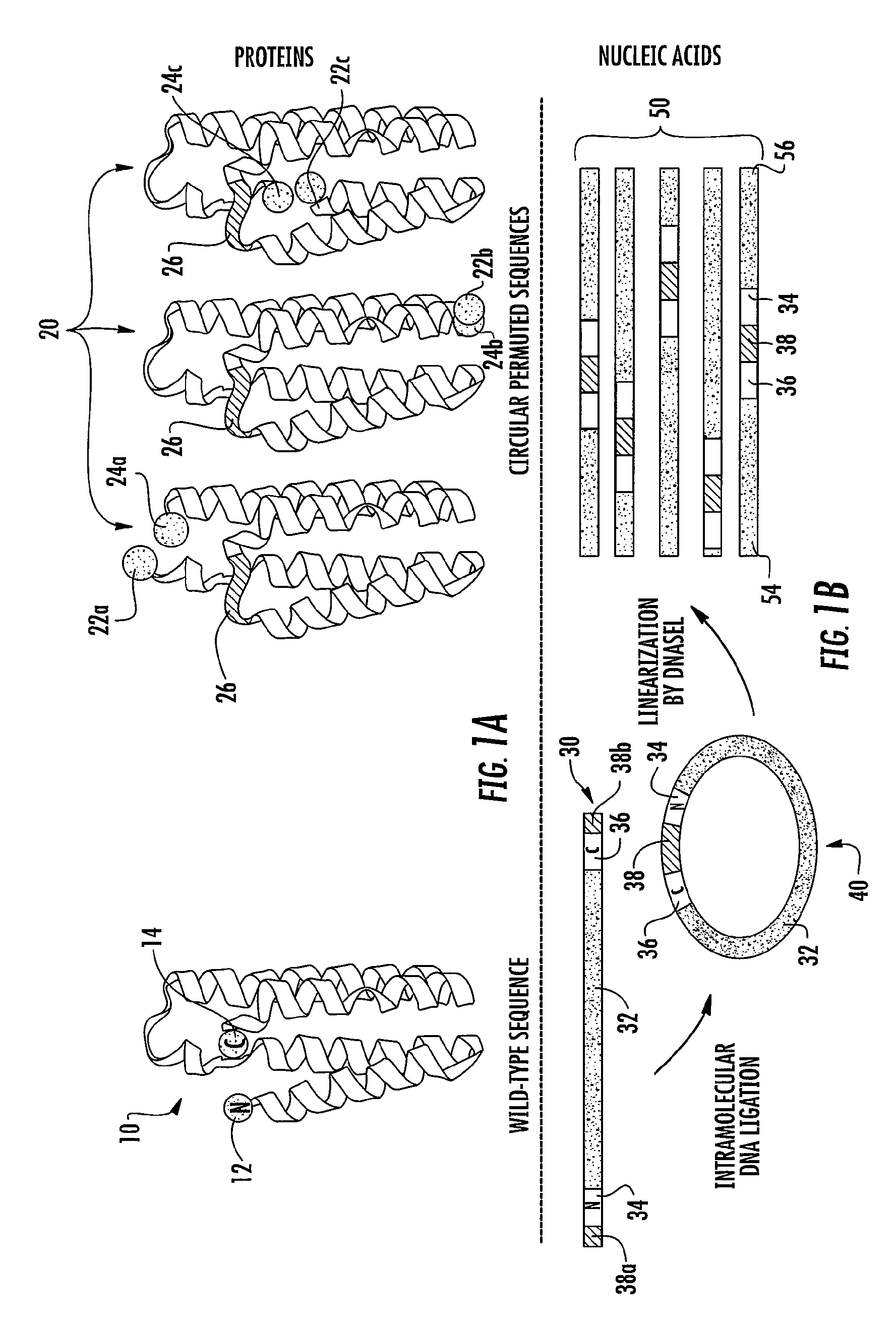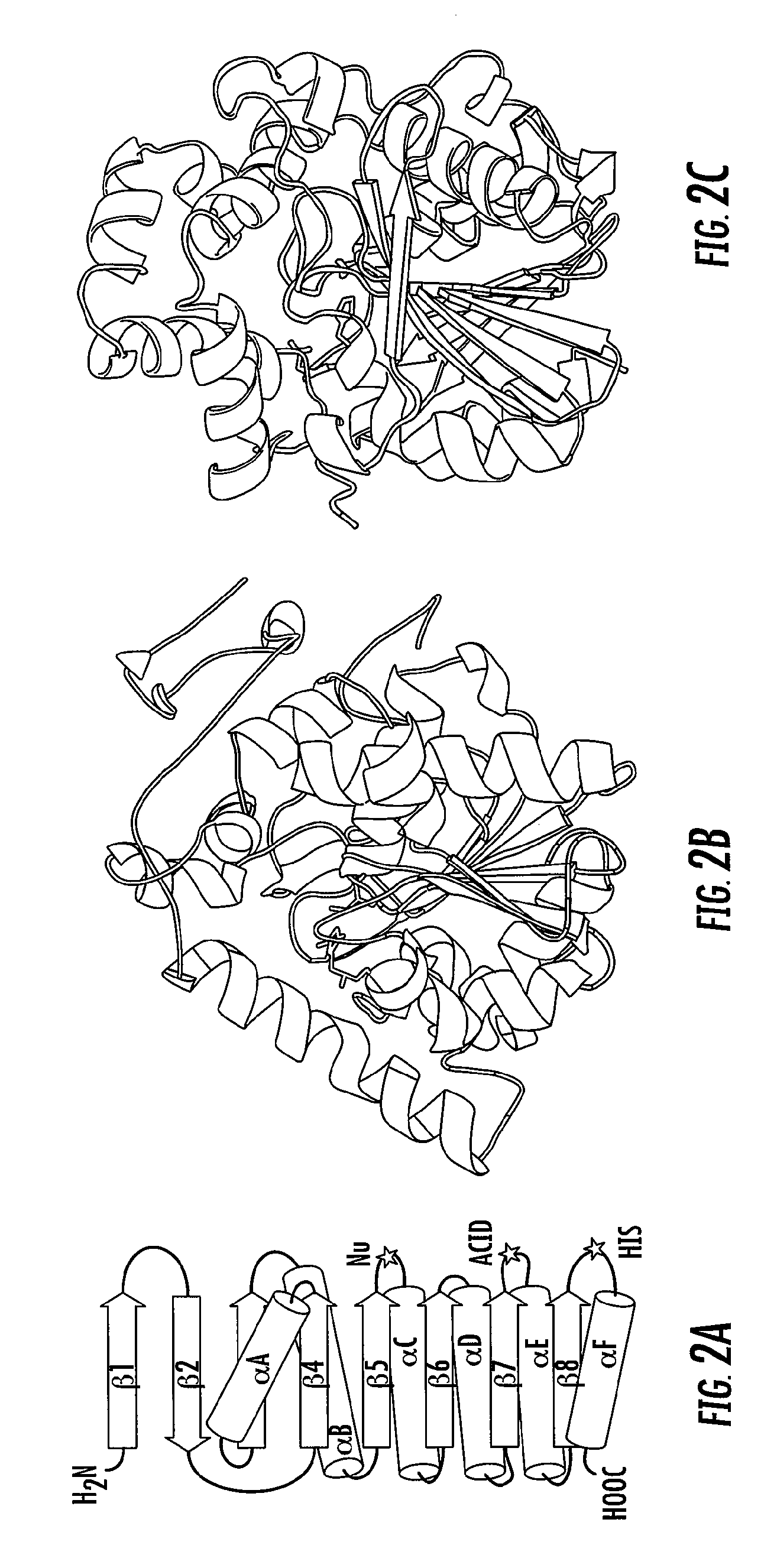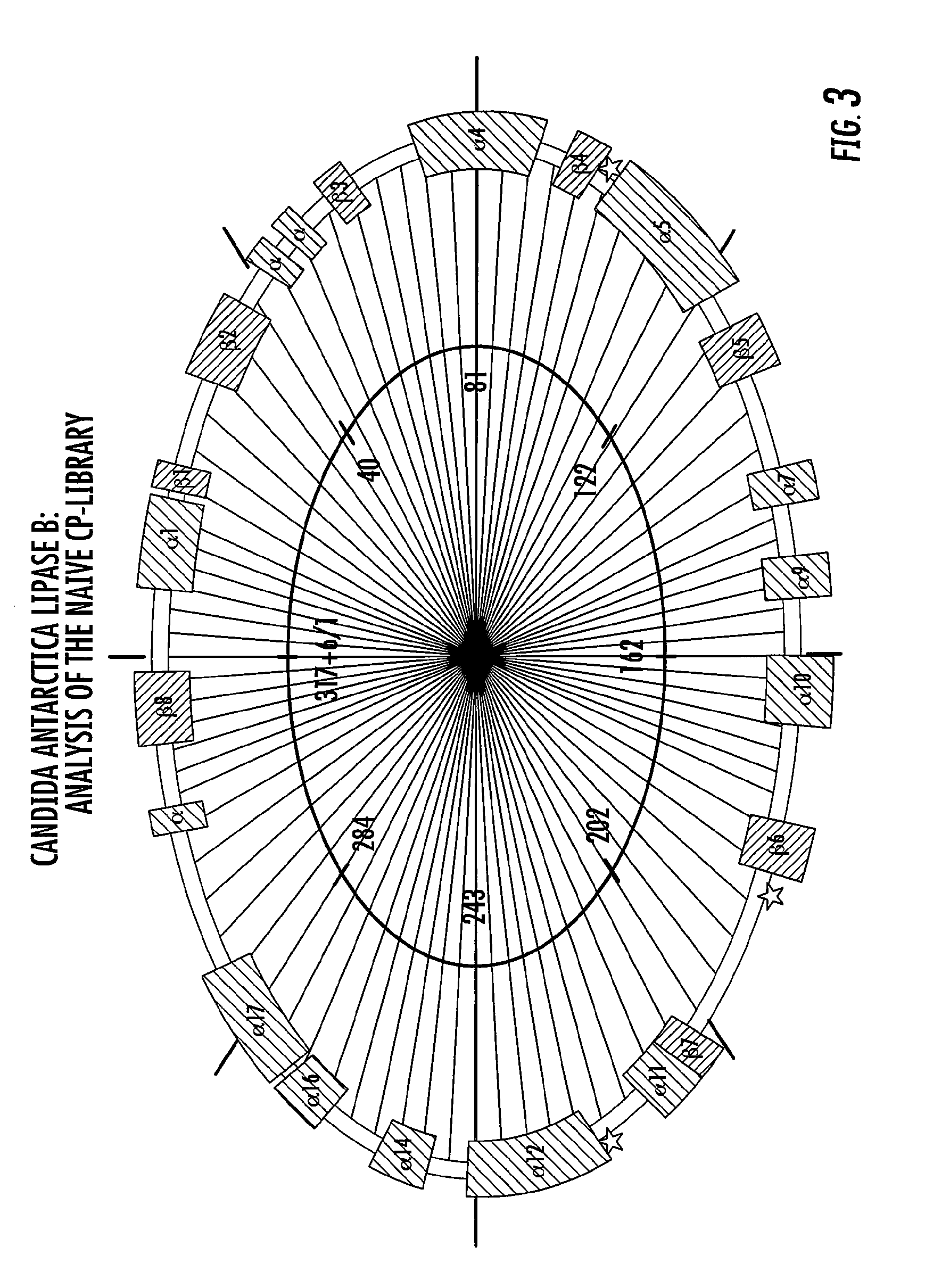Proteins with enhanced functionality and methods of making novel proteins using circular permutation
a technology of protein engineering and functional enhancement, applied in the field of new proteins and peptides, can solve the problems of poor turnover of these substrates, few natural and lab-made lipases show activity and enantioselectivity for bulky substrates, and protein engineers have so far failed to generate improved biocatalysts. , to achieve the effect of improving activity, improving function or behavior, and increasing accessibility to the active si
- Summary
- Abstract
- Description
- Claims
- Application Information
AI Technical Summary
Benefits of technology
Problems solved by technology
Method used
Image
Examples
example 1
Materials
[0170]Chemicals: Fluorogenic substrate 6,8-difluoro-4-methylumbelliferyl octanoate (DiFMU octanoate) and the reference standard 6,8-difluoro-7-hydroxy-4-methylcoumarin (DiFMU) were purchased from Molecular Probes (Eugene, Oreg.). p-Nitrophenyl butyrate (p-NB) was purchased from Sigma (St. Louis, Mo.). Enzymes were purchased from New England Biolabs (Beverly, Mass.) unless noted otherwise.
[0171]Strains and media: Pichia pastoris GS115 (his4) (Invitrogen, Carlsbad, Calif.) was used for the lipase expression. E. coli strain DH5α-E(Invitrogen, Carlsbad, Calif.) was used for all vector constructions. P. pastoris was grown in YPG medium (10 g yeast extract, 20 g bacto peptone, 20 g glucose per liter). BMGY medium (10 g yeast extract, 20 g peptone, 13.4 g yeast nitrogen base, 0.4 mg biotin, 10 ml glycerol, and 100 ml 1 M potassium phosphate buffer, pH 6.0 per liter) and BMMY medium (10 g yeast extract, 20 g peptone, 13.4 g yeast nitrogen base, 0.4 mg biotin, 5 ml methanol, and 100...
example 2
Construction of wt-CALB Expression Vectors
[0172]The wild type calB (wt-calB) gene SEQ ID NO: 1 (having protein sequence SEQ ID NO: 2) was isolated from Candida antarctica (ATCC strain #32657) by a two-step PCR amplification using the primers ZQ_CALBfor1 (5′-GAGGCTGAAGCTCATCATCATCATCATCATAGCAGCGGCCTTGTTCCA CGT CTACCTTCCGGTTCGGACCCT-3′) (SEQ. ID NO: 5), ZQ_CALBfor2 (5′-CGCCTCGAGAAAAGAGAGGCTGAAGCT CATCATCATCATCATCAT-3′) (SEQ. ID NO: 6), and ZQ_CALBrev (5′-CGCGCGGCCGCTTAGGGGGTGACGAT GC CGGAGCA-3′) (SEQ. ID NO: 7). The amplified gene included a (His)6 tag followed by a thrombin cleavage site at the N-terminus of the lipase gene. Restriction enzyme recognition sites XhoI and NotI were also introduced into the 5′ and the 3′ ends respectively (recognition sequence underlined). The PCR product was digested with XhoI and NotI and ligated to the vector pPIC9 (Invitrogen, Carlsbad, Calif.) digested with the same restriction enzymes. This construct (pPIC9-calB) brought the CALB gene under the co...
example 3
Random Circular Permutation of calB
[0173]The wt-calB (SEQ ID NO: 1) was amplified by PCR using primers ZQ_cpCALBfor (5′-GGTACTAGTGGTGGCCTACCTTCCGGTTCGGACCCT-3′) (SEQ. ID NO: 8) and ZQ_cpCALBrev (5′-CGCACTAGTACCGCCGGGGGTGA CGATGCCGGAGCA-3′) (SEQ. ID NO: 9) harboring a SpeI site at both ends (underlined). After digestion with SpeI, 5 μg PCR fragment was circularized at a concentration of 2.5 ng / μl with 90 Weiss units T4 DNA ligase (Promega, Madison, Wis.) overnight at 16° C. This construct generated a circular calB with an 18-bp linker sequence (SEQ. ID NO: 4) that encodes Gly-Gly-Thr-Ser-Gly-Gly (SEQ. ID NO: 3) joining the natural N- and C-terminals. The linker designed consisted of a six-amino acid peptide, rich in glycine for flexibility and serine / threonine for hydrophilicity. After ethanol precipitation, the DNA was subjected to exonuclease III (0.4 units / μg DNA, Promega, Madison, Wis.) digestion at 37° C. for 30 min to remove remaining linear DNA. The exonuclease III was inactiv...
PUM
| Property | Measurement | Unit |
|---|---|---|
| pressure | aaaaa | aaaaa |
| temperature | aaaaa | aaaaa |
| concentration | aaaaa | aaaaa |
Abstract
Description
Claims
Application Information
 Login to View More
Login to View More - R&D
- Intellectual Property
- Life Sciences
- Materials
- Tech Scout
- Unparalleled Data Quality
- Higher Quality Content
- 60% Fewer Hallucinations
Browse by: Latest US Patents, China's latest patents, Technical Efficacy Thesaurus, Application Domain, Technology Topic, Popular Technical Reports.
© 2025 PatSnap. All rights reserved.Legal|Privacy policy|Modern Slavery Act Transparency Statement|Sitemap|About US| Contact US: help@patsnap.com



